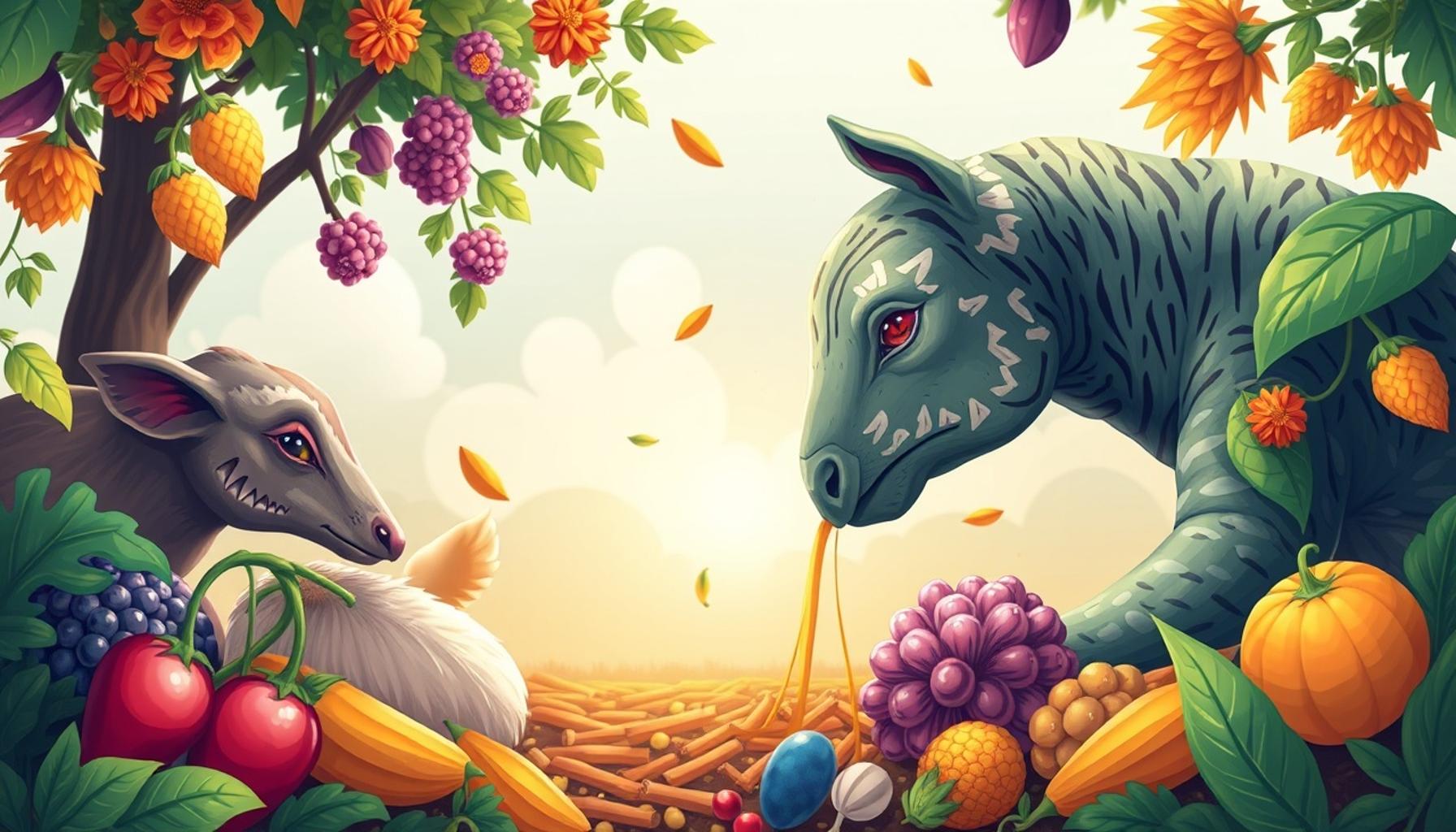The Impact of Climate Change on the Availability of Ingredients for Pet Food in Nigeria

Understanding the Impact of Climate Change on the Pet Food Industry in Nigeria
As Nigeria grapples with the harsh realities of climate variability, the repercussions extend beyond the immediate concerns of agriculture and human livelihoods to encompass the pet food industry. The landscape of animal nutrition is slowly being rewritten as traditional sources of ingredients dwindle and prices soar, leaving pet owners facing an uncertain future for their beloved companions.
One of the most pressing challenges is crop yield decline. Farmers are increasingly struggling to cultivate staple crops essential not just for human consumption but also for pet food production. For instance, drought conditions can significantly reduce the yields of essential grains such as maize and sorghum, which are pivotal in the formulation of many commercial pet foods. Data from the Nigerian Meteorological Agency indicates that erratic rainfall patterns can lead to a decrease in agricultural output by as much as 25% in certain regions, leading to ingredient shortages that directly affect the availability of quality pet food.
Moreover, the health of livestock is also at stake due to rising temperatures. Livestock health is critical not only for meat and dairy products but also influences the ingredients used in pet foods, such as fish meal and animal by-products. As heat stress becomes a more common ailment among animals, their productivity declines, thus limiting the supply of protein-rich ingredients essential for pet diets. For example, poultry facing severe heat can produce fewer eggs and lower-quality meat, impacting the pet food market that relies on these sources for high-quality protein.
Equally concerning is the issue of water scarcity. Access to clean and sufficient water is vital for both crops and livestock. In many northern states, the frequency of drought has escalated, leading to fierce competition for water between agricultural needs and domestic use. This scarcity directly influences the production of fresh produce—such as vegetables and fruits—that could serve as nutritious additions to pet diets. Without adequate water resources, not only do pet food manufacturers face challenges sourcing fresh, healthy ingredients, but costs are likely to surge, passed down to consumers.
As a result, pet owners in Nigeria are confronted with rising prices and a limited selection of nutritious options. The potential for ingredient shortages in the pet food market creates a ripple effect that can hinder overall animal well-being. Understanding the intricate relationship between climate change and food supply chains is crucial for pet owners striving to maintain a balanced diet for their companions. Awareness and adaptation are key; exploring alternatives like locally sourced ingredients or engaging in community-driven agricultural initiatives can potentially alleviate these pressing challenges.
This evolving landscape calls for collaboration among stakeholders, including farmers, pet food manufacturers, and consumers. As climate change continues to reshape our environment, the resilience of the pet food industry will depend on collective efforts to innovate and adapt to these new realities. Only through understanding the depth of these changes can Nigerians safeguard the health of their pets amidst an uncertain climate future.
LEARN MORE: This related article may interest you
The Compounding Challenges of Ingredient Sourcing Amid Climate Change
The escalating effects of climate change in Nigeria are reshaping the dynamics of ingredient sourcing for the pet food industry. With the consistent decline in agricultural productivity, understanding the multifaceted challenges that pet food manufacturers and consumers face is crucial. The interconnection between climate-induced agricultural issues and the availability of pet food ingredients has become increasingly apparent, turning a once-stable market into a precarious one.
One significant consequence of climate change is the shift in agricultural zones. As temperatures rise and rainfall patterns become unpredictable, regions that once thrived on crop cultivation are now struggling. For farmers in key agricultural states like Kaduna and Kano, this shift means adapting to new crops or investing in irrigation systems that may not provide immediate returns. This relentless alteration impacts both human and animal food sources, as many staple ingredients—such as cassava, yam, and grains—become less accessible. The demand for these crops not only sustains human diets but also invigorates the pet food market, reinforcing the link between food security and climate stability.
Moreover, the issue of pest and disease prevalence further complicates the landscape. Warmer temperatures can lead to an increase in pests and diseases that affect both crops and livestock, ultimately jeopardizing the quality and quantity of ingredients available for pet foods. For example, the fall armyworm has wreaked havoc on maize crops, while diseases like Newcastle disease threaten poultry. Such developments not only inflate ingredient prices but also cause erratic supply chains, negatively impacting pet food production.
The Rising Cost of Nutritious Ingredients
With the convergence of these challenges, pet food manufacturers may find themselves in a bind. The rising cost of essential ingredients means higher prices for consumers. Here are some factors to consider regarding the impact of climate change on ingredient availability for pet food:
- Increased ingredient prices: As competition for limited resources intensifies, ingredient prices are expected to soar. This situation forces pet food companies to either compromise on quality or pass these costs onto consumers.
- Limited product diversity: A decline in the availability of varied high-quality ingredients may curb the diversity of pet food options on the market, making it harder for pet owners to find appropriate nutrition.
- Shift towards alternative sources: With traditional protein sources like fish meal becoming scarce, there is a growing need to explore alternative protein sources such as insects and plant-based options.
The challenges presented by climate change are not to be taken lightly, as their impact resonates through every layer of the pet food supply chain. As pet owners in Nigeria strive to provide the best nutrition for their pets amidst these shifting tides, understanding the evolution of ingredient sourcing becomes imperative. Knowledge and proactive measures may help mitigate these pressing challenges, ensuring the well-being of cherished companions in an uncertain climate landscape.
The Impact of Climate Change on Pet Food Ingredients in Nigeria
Climate change is increasingly becoming a pressing issue that affects various sectors, including the pet food industry in Nigeria. This nation, rich in agricultural diversity, faces significant challenges in sourcing ingredients vital for pet nourishment. As weather patterns become erratic, the availability of key crops such as maize, cassava, and soybeans, essential components in pet food production, is threatened.One major impact of climate change is the increased frequency of droughts and flooding. These extreme weather events not only devastate local crops but also lead to fluctuations in pricing and availability. For example, when maize crops fail due to lack of rainfall, pet food manufacturers are left scrambling for alternative sources, driving up costs and potentially compromising nutritional quality. Furthermore, adverse conditions can reduce the size and quality of yields, thus exacerbating food shortages across both the human and animal food supply chains.The implications of these changes go beyond just potential shortages. The economic ramifications are significant; agricultural workers may lose their livelihoods as traditional farming practices prove insufficient against a changing climate. This, in turn, can limit the variety of ingredients available for pet food production, potentially leading to increased reliance on imported alternatives that may not meet the same nutritional standards as locally sourced ingredients.It is also important to note the growing interest in sustainable pet food practices. As climate-related challenges escalate, consumers are becoming more conscious of their pets’ diets and the origins of their food. This shift opens up opportunities for the industry to innovate and adapt. Manufacturers who invest in sustainable sourcing methods or alternative protein sources, such as insects or lab-grown materials, may find a niche market as pet owners prioritize environmental responsibility alongside pet health.To fully grasp the evolving landscape of the pet food market due to climate change, stakeholders must explore new agricultural techniques and sustainable practices that can mitigate these effects. Engaging in research and collaboration will be crucial in redefining sourcing strategies, ensuring that quality pet food remains accessible in a climate-affected Nigeria. Finally, NGOs and government initiatives must work in concert to educate farmers on climate resilience methods and support them in transitioning toward more sustainable practices. The focus on education, innovation, and adaptive strategies is pivotal for safeguarding both the pet food industry and broader agricultural stability in Nigeria amid the ongoing challenges posed by climate change.
| Advantage | Impact on Pet Food |
|---|---|
| Sustainable sourcing | Reduces dependency on volatile crops and localizes production. |
| Innovation in ingredients | Encourages the development of alternative protein sources, enhancing nutritional diversity. |
CHECK OUT: Click here to explore more
Adapting to Change: Innovations and Solutions in Pet Food Ingredient Sourcing
As climate change continues to challenge the pet food industry in Nigeria, innovation emerges as a beacon of hope for manufacturers and consumers alike. The necessity for resilience drives stakeholders to explore new pathways in securing essential ingredients. This section examines how adaptation strategies and creative solutions are forming the future of ingredient sourcing in the Nigerian pet food market.
One emerging strategy is the adoption of sustainable agricultural practices. Farmers throughout Nigeria are becoming increasingly aware of the benefits of crop rotation, agroforestry, and organic farming techniques to bolster resilience against climate disruptions. By diversifying the types of crops planted, these practices help stabilize yields while fostering healthier ecosystems. For instance, integrating legumes into traditional cereal rotations not only enriches the soil but also supports the availability of protein-rich ingredients, which are vital in producing nutritious pet food.
Another noteworthy solution is the increased emphasis on local sourcing. With the unpredictable nature of climate change affecting supply chains, pet food manufacturers are beginning to prioritize locally sourced ingredients. By supporting local farmers and utilizing region-specific crops, companies can enhance ingredient availability while reducing carbon footprints associated with transportation. For example, locally produced millet and sorghum can supplement existing imports of grains, fostering a sense of community while ensuring pet food remains affordable.
Exploration of Alternative Ingredients
The urgent need to adapt also paves the way for exploring alternative ingredients. Recent trends indicate a shift towards unconventional protein sources, such as insects, algae, and even lab-grown meats, as solutions to traditional ingredient shortages. Insects, such as crickets and mealworms, offer high protein content and require significantly fewer resources compared to conventional livestock. Research institutions and entrepreneurs in Nigeria are beginning to tap into this potential, offering innovative solutions to manufacturers eager to diversify their ingredient profiles.
Moreover, plant-based protein sources, like soy and pea protein, have garnered attention as replacements amid rising costs of animal-based proteins. With a growing interest in vegetarian and vegan diets for pets, utilizing these alternative ingredients not only addresses ingredient scarcity but also appeals to an expanding market segment concerned about ethical and environmental impacts.
Role of Technology in Monitoring and Supply Chain Management
The advancement of technology plays a pivotal role in fortifying the pet food supply chain against the uncertainties posed by climate change. Innovations in precision agriculture enable farmers to monitor soil health, optimize water usage, and use fertilizers judiciously, enhancing crop yields despite adverse weather conditions. Additionally, technologies such as blockchain offer transparency in sourcing practices, ensuring that pet food manufacturers can trace the origins of their ingredients. This traceability cultivates consumer trust and informs more sustainable choices.
In response to these changing dynamics, pet food companies in Nigeria are also investing in research and development to innovate resilient products. By collaborating with agricultural experts and leveraging local knowledge, they can tailor offerings that meet the nutritional needs of pets while accommodating ingredient availability challenges.
The path forward requires constant adaptation and progressive thinking to address the sustainability of both human and pet food systems. As Nigeria’s pet food market navigates the turbulent waters of climate change, fostering collaboration among all stakeholders will be pivotal to achieving a stable and nutritious future for pets and their owners.
YOU MAY ALSO LIKE: Read read another article
Conclusion: Navigating the Future of Pet Food Ingredients in Nigeria
The challenges posed by climate change on the availability of pet food ingredients in Nigeria are undeniable, yet they illuminate pathways toward innovative and sustainable solutions. As manufacturers grapple with the impact of unpredictable weather patterns and shifting agricultural practices, the importance of sustainable farming and local ingredient sourcing has never been more evident. Emphasizing regional crops not only enhances ingredient reliability but also benefits local economies and reduces environmental footprints.
Furthermore, the exploration of alternative protein sources is taking center stage, as stakeholders recognize the need to adapt to ingredient scarcity. With the rise of insect farming and plant-based protein options, the market can diversify, catering to changing consumer preferences and promoting nutrition without compromising sustainability.
Technological advancements, such as precision agriculture and blockchain, offer promising tools to bolster supply chain resilience and transparency. By leveraging these innovations, stakeholders can better navigate the complexities of climate change, ensuring that pet food manufacturers can secure high-quality ingredients while fostering consumer trust.
As we look ahead, collaboration among farmers, manufacturers, and policymakers will be crucial. Addressing the impact of climate change on pet food ingredients is not only a matter of safeguarding pet health but also recognizing the interconnectedness of food systems. The future of Nigeria’s pet food market hinges on our ability to innovate, adapt, and embrace sustainable practices, ultimately leading to a secure and nutritious future for both pets and their loving owners.


